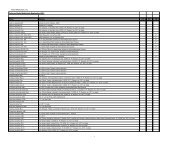Cordyceps - Aloha Medicinals Inc.
Cordyceps - Aloha Medicinals Inc.
Cordyceps - Aloha Medicinals Inc.
You also want an ePaper? Increase the reach of your titles
YUMPU automatically turns print PDFs into web optimized ePapers that Google loves.
4 <strong>Cordyceps</strong><br />
But modern collectors have found that more weight<br />
can be gained if a bit of wire is inserted into the caterpillar,<br />
rather than the traditional twig. As long as the<br />
wire is steel, such a practice, as is the case with the<br />
aforementioned wood insertion, is probably not too<br />
harmful. Unfortunately, the wire of choice is now lead<br />
solder. A careful examination of the ends of the caterpillars<br />
will often reveal the holes where the sticks or<br />
wire have been inserted (Fig. 2), and anyone who<br />
chooses to use the wild collected <strong>Cordyceps</strong>, rather<br />
than the cultivated variety, would be well advised to<br />
break each one of the caterpillars in half before use,<br />
so that any bits of foreign matter can be readily<br />
discerned and removed.<br />
Cultivated cordyceps appears to offer far less risk of<br />
lead contamination than the wild type. The presence<br />
of lead or other substances in the growth medium<br />
certainly could be absorbed by any growing organism.<br />
We have conducted chemical analysis on many thousands<br />
of <strong>Cordyceps</strong> samples over the years and observed<br />
that <strong>Cordyceps</strong> does not have any more tendency to<br />
accumulate lead or other heavy metals than do any other<br />
fungi.<br />
GENERAL NUTRITIONAL COMPONENTS<br />
OF CORDYCEPS<br />
Chemical Constituents<br />
<strong>Cordyceps</strong> contains a broad range of compounds, which<br />
are considered nutritional. [1,2] It contains all of the essential<br />
amino acids, vitamins E and K, and the water-soluble<br />
vitamins B1, B2, and B12. In addition, it contains many<br />
sugars, including mono-, di-, and oligiosaccharides, and<br />
many complex polysaccharides, proteins, sterols, nucleosides,<br />
and trace elements (K, Na, Ca, Mg, Fe, Cu, Mn,<br />
Zn, Pi, Se, Al, Si, Ni, Sr, Ti, Cr, Ga, V, and Zr).<br />
Potentially bioactive constituents<br />
Cordycepin [3 0 -deoxyadenosine] and cordycepic acid<br />
[D-mannitol] were the initial bioactive compounds first<br />
isolated from C. militaris. Chen and Chu [6] announced<br />
the characterization of cordycepin and 2 0 -deoxyadenosine,<br />
using nuclear magnetic resonance (NMR) and<br />
infrared spectroscopy (IR) in an extract of C. sinensis.<br />
Other components found included various saccharides<br />
and polysaccharides, including cyclofurans, which are<br />
cyclic rings of five-carbon sugars, whose function is<br />
yet unknown, beta-glucans, beta-mannans, crosslinked<br />
beta-mannan polymers, and complex polysaccharides<br />
consisting of both five- and six-carbon sugars joined<br />
together in branching chains, employing both alphaand<br />
beta-bonds. Many other nucleosides have been<br />
found in <strong>Cordyceps</strong>, including uridine, several distinct<br />
structures of deoxyuridines, adenosine, 2 0 3 0 -dideoxyadenosine,<br />
hydroxyethyladenosine, cordycepin [3 0 -<br />
deoxyadenosine], cordycepin triphosphate, guanidine,<br />
deoxyguanidine, and altered and deoxygenated nucleosides,<br />
which were not found anywhere else in nature<br />
(Fig. 3). Of particular note are various immunosuppressive<br />
compounds found in <strong>Cordyceps</strong>, including<br />
cyclosporin, a constituent of the species C. subsessilis<br />
[anamorph: Tolypocladium infalatum]. [29] Other immunosuppressant<br />
compounds have also been found in<br />
Isaria sinclairii, a species closely related to <strong>Cordyceps</strong>. [7]<br />
Polysaccharides<br />
In the fungal kingdom, and particularly in <strong>Cordyceps</strong>,<br />
polysaccharides are perhaps the best known and<br />
understood of the medicinally active compounds. [8,9]<br />
A number of polysaccharides and other sugar derivatives,<br />
such as cordycepic acid [D-mannitol], have been<br />
identified. Research has shown that these polysaccharides<br />
are effective in regulating blood sugar, [10] and<br />
have antimetastatic and antitumor effects. [11]<br />
Proteins and nitrogenous compounds<br />
<strong>Cordyceps</strong> contains proteins, peptides, polyamines,<br />
and all essential amino acids. In addition, <strong>Cordyceps</strong><br />
contains some uncommon cyclic dipeptides, including<br />
cyclo-[Gly-Pro], cyclo-[Leu-Pro], cyclo-[Val-Pro],<br />
cyclo-[Ala-Leu], cyclo-[Ala-Val], and cyclo-[Thr-Leu].<br />
Small amounts of polyamines, such as 1,3-diamino<br />
propane, cadaverine, spermidine, spermine, and putrescine,<br />
have also been identified.<br />
Sterols<br />
A number of sterol type compounds have been found<br />
in <strong>Cordyceps</strong>: ergosterol, Delta-3 ergosterol, ergosterol<br />
peroxide, 3-sitosterol, daucosterol, and campeasterol,<br />
to name a few. [12]<br />
Other constituents<br />
Twenty-eight saturated and unsaturated fatty acids<br />
and their derivatives have been isolated from C. sinensis.<br />
Polar compounds of <strong>Cordyceps</strong> extracts include<br />
many compounds of alcohols and aldehydes. [12] Particularly<br />
interesting are the range of polycyclic aromatic<br />
hydrocarbons produced by C. sinensis as secondary<br />
metabolites. These PAH compounds react with the<br />
polypropylene used in common mushroom culture<br />
bags, resulting in the production of byproducts toxic<br />
to <strong>Cordyceps</strong> that stunt its growth as time progresses.<br />
Eventually, these polypropylene=PAH byproducts will<br />
kill the organism. For extended periods of growth,




